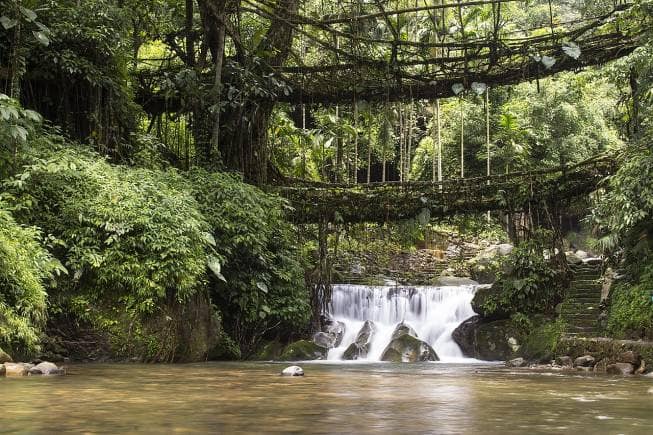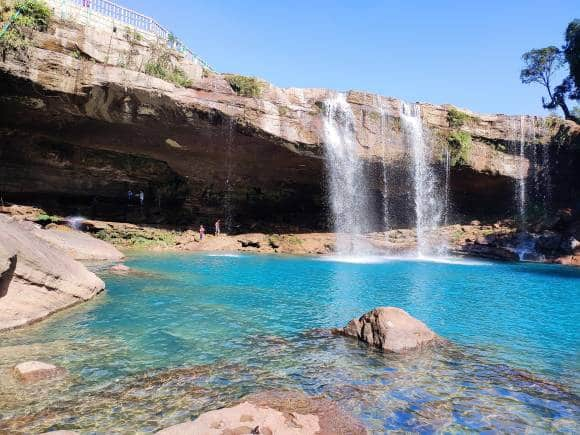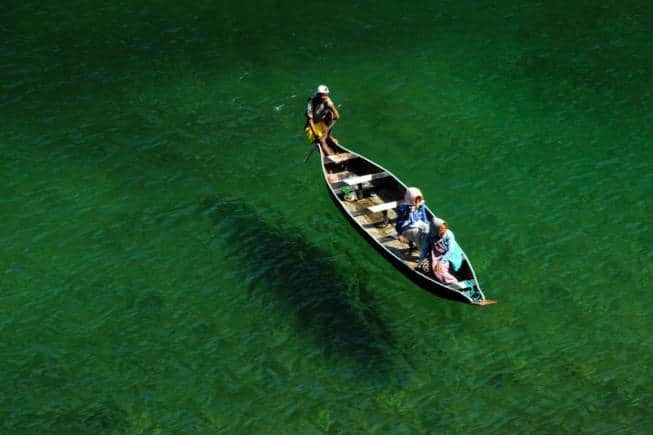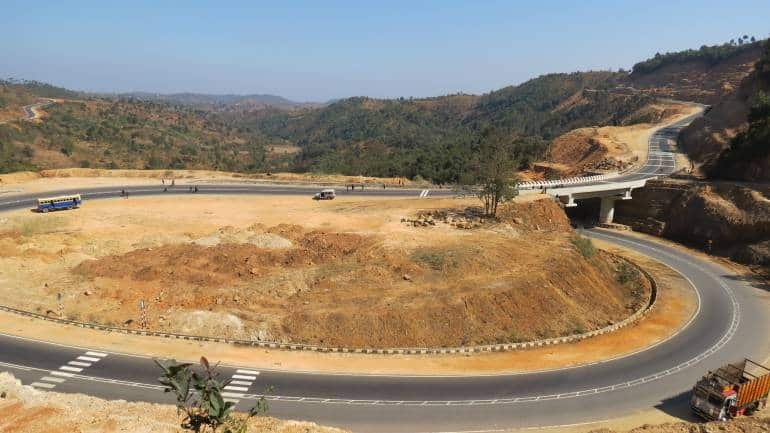



No trip to the Northeast can be complete without including Meghalaya, or the abode of the clouds, in your itinerary. What’s so special about Meghalaya? In fact, what’s not special about it?
Lush-green and misty mountains, naturally-formed landscapes that resemble a golf course, clouds that breeze into your verandah, countless waterfalls, rivers with crystal-clear emerald green water, ancient caves, sprawling lakes, clean villages, and beautiful, chilled-out people — Meghalaya has everything to draw a tourist.
There are two ways to draw out a trip to Meghalaya — visit it to enjoy the magic of monsoon, but risk getting stuck in some of the heaviest rain in India, or enjoy the winter in bone-chilling cold if you can dare. But ideally, like most other tourist spots, October to March is the preferred season by the majority.
In and around Shillong
 Laitlum Canyon, Meghalaya. (Photo: Wikimedia Commons)
Laitlum Canyon, Meghalaya. (Photo: Wikimedia Commons)
You can begin your tour by visiting Shillong, Meghalaya’s capital city, also referred to as the "Scotland of the East" because of the rolling hills surrounding it. Local folklore has it that when the British settlers arrived in Shillong, it reminded them of Scotland because of the similarities in the landscape.
Shillong in itself is a complete package, with lakes, waterfalls, markets, rock music, and good food. Meghalaya being a Christian-majority state, the year-end especially gets lively and spirited because of the Christmas and New Year celebrations.
Prominent spots in and around Shillong that you must not miss are the roaring Elephant falls; Shillong Peak, the highest point that offers panoramic views of the city and the surroundings; the towering Cathedral of Mary Help of Christians, which is completely set in blue; Ward’s Lake; Laitumkhrah, which has some cool cafés; the heritage Tripura Castle, now a hotel; Upper Shillong Forest; the stunning Laitlum canyon; Polo Ground; and the vast Umiam Lake.
But the soul of the city is Police Bazaar, for all kinds of low-cost shopping and luscious Indo-Chinese street food, such as spicy hot momos, chow and chilli pork as well as local Khasi dishes such as tungrymbai (fermented soybean dish), which may require an acquired taste, jadoh (rice and meat dish), dohneiiong (pork in black sesame seed paste), smoked meats, dohkhlieh (boiled pig-brain salad), and pukhlein (deep-fried rice-flour and jaggery snack).
If you are a quiet person and want to spend time with yourself, then you can stay beside the sprawling man-made Umiam Lake, popularly known as Barapani, just 15 km from Shillong, on the Guwahati-Shillong road. Spread over more than 225 sq. km, the vastness of Umiam with its still, blue waters as far as your eyes can see is sure to leave you spellbound.
Accommodation beside the lake, however, may pinch your pocket if you are a budget traveller. Open from 9 am to 5 pm, various water-sport activities such as sailing, water-skiing, water-scooter and boat ride are available.
Sohra (Cherrapunji), caves and root bridges
 Double-decker living-roots bridge, Sohra/Cherrapunji. (Photo: Wikimedia Commons)
Double-decker living-roots bridge, Sohra/Cherrapunji. (Photo: Wikimedia Commons)
Another unmissable spot is Sohra, the original name for Cherrapunji (the Britishers couldn't pronounce, and Sohra became Cherra, and has been reverted to Sohra again). One of the wettest places on earth, it is nestled around 55 km south of Shillong. The idyllic road trip through the winding roads and the misty hills amid the unpredictable weather — which can turn cloudy in one moment and sunny in the next — is a mesmerising experience in itself.
If you are lucky enough to be on a sunny and clear day, you can immerse yourself in the beauty of Cherrapunji’s bewitching waterfalls — there are, at least, eight of them. Nohsngithiang or the Seven Sisters waterfalls is arguably India’s fourth-highest fall, by most accounts, where the water falls from a height of more than 1,000 ft in seven lines, and the third-highest at more than 1,100 ft is Nohkalikai, which has a tragic story behind its name, translated as "the jump of Likai".
The other waterfalls include Kynrem, Dainthlen, Wah-Kaba, Rainbow, Laitmawsiang, Canyon or Wakaba Waterfall, etc.
What have you done in Meghalaya if you haven’t walked on the living-root bridges, which are in UNESCO’s tentative list of World Heritage sites. Or, crawled through the ancient caves? These fascinating formations can be part of your Sohra tour.
Locally known as jingkieng jri, the living-root bridges, some of which are hundreds of years old, are found in more than 70 villages in the southern parts of Meghalaya. The most famous of them are the ones in Rangthylliang or the double-decker bridge in Nongriat. But be ready to walk up and down hundreds of steps through the dense jungles, with study hiking shoes.
Meghalaya also had a wide network of complex cave systems with magnificent formations of stalagmites and stalactites, many of whom are still unexplored and inaccessible. The Krem Liat Prah in Jaintia Hills, said to be the longest cave in Meghalaya, would require a long detour, but you can also visit the equally stunning Mawsmai and Arwah caves near Sohra.
You can end your memorable trip to Sohra with a visit to Mawlynnong, Asia’s cleanest village, which also has many root bridges, and Mawsynram, the world’s wettest place, on your way back. Two nights of stay at Sohra is a must if you want to experience all these nature’s delights.
Dawki-Krang Suri Falls
 Krang Suri waterfall, Meghalaya. (Photo: Wikimedia Commons)
Krang Suri waterfall, Meghalaya. (Photo: Wikimedia Commons)
Located along the India-Bangladesh border, about 90 km from Shillong, Dawki is a sleepy settlement of a few thousand people and border checkpoint. So what’s special about it that made it so famous? The Umngot river, with emerald green water that is so crystal clean that you can see the bottom on a calm day. A ride on a dinghy along the river that is lined up with countless little waterfalls makes the ride special.
Dawki doesn’t have established hotels but some villagers offer homestays and jungle camps with trekking facilities. The area goes dead silent after dusk and a night stay is not for the fainthearted, though the place is safe for tourists. But if you seek a comfortable stay, you can make a day tour to Dawki from either Shillong or Cherrapunji, which has many hotels and resorts.
On the way back, you can take a small detour to visit the Krang Suri waterfall in Jowai with azure blue waters if you are longing for some stunning photos and enjoy steaming Maggi under the winter sun. Some operators in Shillong organise limited night stay camping tours to Krang Suri at affordable packages. So if you are lucky, you might just enjoy a night under the bright sky as well.
Points to remember
 Dawki river, Meghalaya. (Photo: Wikimedia Commons)
Dawki river, Meghalaya. (Photo: Wikimedia Commons)
A few spots would require you to pass through army cantonment areas so better keep your ID cards handy. A nominal fee is charged on entry to Shillong Peak, Elephant Falls, Ward’s Lake, Dawki village, and many other tourist spots.
Local taxis can be flagged down for commuting within Shillong. Small and big cabs are available for outstation tours and packages. It’s better to book one operator for the entire tour but be ready to bargain. If you are self-driving, do not break traffic rules.
In Shillong, all kinds of budget accommodation and mid-range hotels are available, mainly around Police Bazar. Shillong also offers some excellent homestays but be sure to do some research and book in advance. Ample accommodation of all ranges is also available around Cherrapunji.
While in Shillong, or Meghalaya, remember that the sun rises and sets much earlier than the rest of India. So the roads would empty out after 7.30 pm, especially in winters.
How to reach
 Shillong Bypass road. (Photo: Wikimedia Commons)
Shillong Bypass road. (Photo: Wikimedia Commons)
Getting to Meghalaya is very easy. Shillong has an airport but only limited flights are available. The nearest airport and railway station is Guwahati, which is well connected to other major cities of India.
Plenty of taxis and buses are available to Meghalaya from Guwahati, which is a three-four hour ride from Shillong. A single taxi-ride to Shillong from the Guwahati railway station would cost about Rs 2,500 and Rs 1,000 more from the airport. Tour operators in Guwahati also offer complete Meghalaya packages.
Discover the latest Business News, Sensex, and Nifty updates. Obtain Personal Finance insights, tax queries, and expert opinions on Moneycontrol or download the Moneycontrol App to stay updated!
Find the best of Al News in one place, specially curated for you every weekend.
Stay on top of the latest tech trends and biggest startup news.